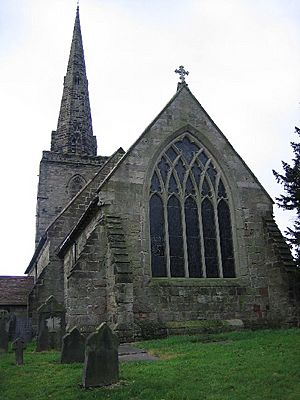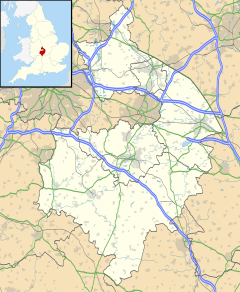Seckington facts for kids
Quick facts for kids Seckington |
|
|---|---|
 All Saints' parish church, seen from the east |
|
| Population | 59 (2001 Census) |
| OS grid reference | SK2607 |
| Civil parish |
|
| District |
|
| Shire county | |
| Region | |
| Country | England |
| Sovereign state | United Kingdom |
| Post town | Tamworth |
| Postcode district | B79 |
| Dialling code | 01827 |
| Police | Warwickshire |
| Fire | Warwickshire |
| Ambulance | West Midlands |
| EU Parliament | West Midlands |
| UK Parliament |
|
Seckington is a small village and civil parish in North Warwickshire, England. It's about 4 miles (6.4 km) northeast of Tamworth. A road called the B5493, which connects Tamworth and Appleby Magna, goes right through the area, passing close to the village.
Seckington shares a local council with two other places, Newton Regis and No Man's Heath. It's very close to the border with Staffordshire. In fact, Seckington is the second most northern village in Warwickshire. Only No Man's Heath is further north, and the village is just 3.5 miles (5.6 km) south of the Derbyshire border.
Seckington's Early History

Seckington has a long and interesting history! Back in the year 757, a powerful king named Æthelbald, who ruled the kingdom of Mercia, was killed at a place called Secandune. This is what Seckington was known as back then.
Old historical writings, like the Historia ecclesiastica gentis Anglorum, say that King Æthelbald was "treacherously and miserably murdered, in the night, by his own guards."
Later, in 1086, a very important book called the Domesday Book was created. It recorded details about land and property across England. This book mentions Secintone as a small village (called a vill) with a large estate (a manor) that was about five hides in size. A hide was an old way of measuring land.
Seckington Castle
Seckington is home to a special kind of old castle called a motte-and-bailey castle. Experts believe it was built in the late 1000s. It might have been built for Roger de Beaumont, an Earl from Meulan, or for his son, Robert de Beaumont.
In the late 1600s, a historian named Sir William Dugdale carefully described and measured the castle. Since 1923, Seckington Castle has been protected as a scheduled monument. This means it's a very important historical site.
Today, the motte (which is the large mound the castle stood on) is about 30 feet (9.1 meters) high. Its base is about 150 feet (46 meters) wide. The bailey, which was the enclosed courtyard area, is located to the south and east of the motte. Around the castle, you can still see traces of old farming fields, which look like ridges and furrows in the ground.
All Saints' Church
The local Church of England church is called All Saints. It was probably built in the mid-to-late 1200s. However, it was changed a lot in the late 1800s during a time called the Victorian restoration.
The tall west tower and its pointy top (called a spire) were rebuilt in 1883. Workers used many of the original stones. The openings for the bells are in an old style called Early English. The west window has a wavy, S-shaped curve (called an ogee) and is in a style called Decorated Gothic. The top edge of the tower (the parapet) and the spire are in a style called Perpendicular Gothic. The spire has two sets of small windows (called lucarnes).
The main part of the church (the nave) and the area near the altar (the chancel) are in the Decorated Gothic style, with windows from the 1300s. The large east window in the chancel has five sections and a criss-cross pattern (called tracery). It is thought to have been made wider during the restoration.
You can see the wavy ogee shape used a lot in the church. It's in the west window, two south windows of the nave, and some doorways. There's also a double basin (a piscina) in the chancel with this shape.
All Saints' Church used to have a rood screen and a rood loft. These were wooden screens and platforms that separated the nave from the chancel. You can still see where they were on the east wall of the nave. Outside, on the south wall, there's an old scratched mass dial, which was like a sundial used to tell the time for church services.
Inside the church, there are some interesting old monuments. One is a stone carving of a lady from the early 1300s, dressed in old clothes. Another is a wall-mounted monument from the Jacobean period (early 1600s) for Robert Burdett, who died in 1603. He was an ancestor of the Burdett family, who were important people. His monument is made of marble and has columns with fancy tops (called Corinthian columns) next to kneeling figures of his family.
The west tower has a set of four bells that can be rung in a special way (called change ringing). The oldest bell was made around 1520 and has the name IESUS on it. Another bell was made around 1640. The other two bells were made or remade in 1886 when the tower was rebuilt. It's a bit unusual because the third bell is actually the largest, not the tenor bell (which is usually the biggest).
Since 1953, All Saints' Church has been a Grade II* listed building. This means it's a very important historical building. All Saints is now part of a larger group of churches called the Benefice of All Souls. This group also includes churches from nearby villages like Austrey, Newton Regis, Shuttington, and Warton.
Other Historic Buildings
Seckington also has four other buildings that are listed as Grade II. This means they are important and protected for their history or special architecture.
- Rock Farmhouse has parts that are from the 1600s, with additions made in the late 1700s.
- Old Hall Farmhouse was built in the late 1600s or early 1700s, with more parts added in the late 1700s and early 1800s.
- The Old Rectory was originally from the 1700s, but most of it was rebuilt around 1870.
- Church Farmhouse was built in the late 1700s or early 1800s.



